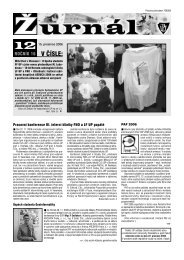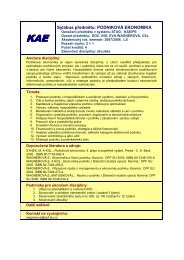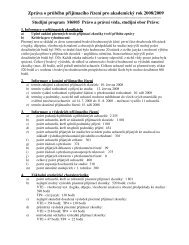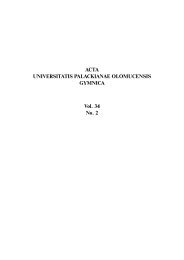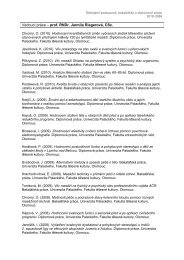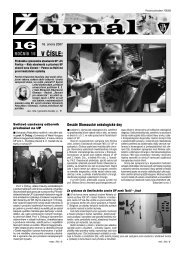Systematic Reviews and Meta-Analyses
Systematic Reviews and Meta-Analyses
Systematic Reviews and Meta-Analyses
Create successful ePaper yourself
Turn your PDF publications into a flip-book with our unique Google optimized e-Paper software.
Types of Studies<strong>Systematic</strong> <strong>Reviews</strong> <strong>and</strong> <strong>Meta</strong>-<strong>Analyses</strong>Important medical questions are typically studied more than once, often by different researchteams in different locations.A systematic review is a comprehensive survey of a topic in which all of the primary studies ofthe highest level of evidence have been systematically identified, appraised <strong>and</strong> thensummarized according to an explicit <strong>and</strong> reproducible methodology.A meta-analysis is a survey in which the results of all of the included studies are similar enoughstatistically that the results are combined <strong>and</strong> analyzed as if they were one study. In general agood systematic review or meta-analysis will be a better guide to practice than an individualarticle.Pitfalls specific to meta-analysis include:1. It's rare that the results of the different studies precisely agree, <strong>and</strong> often the number ofpatients in a single study is not large enough to come up with a decisive conclusion.2. If the authors are interested in supporting a particular conclusion, they can include studiesthat support that conclusion <strong>and</strong> omit studies that do not. Do the authors explain in theirpaper exactly on what basis they included studies , <strong>and</strong> do their reasons make sense?3. Studies that show some kind of positive effect tend to be published more often than thosethat do not. This means that if the authors include only published studies, several weakpositive studies may seem to add up to a strong positive result. Do weak negative studiesexist? This effect is known as Publication bias.From: SUNY Downstate EBM Tutorialhttp://library.downstate.edu/EBM2/research.htm
R<strong>and</strong>omized Controlled StudiesA r<strong>and</strong>omized controlled study is one in which:1. There are two groups, one treatment group <strong>and</strong> one control group. The treatment groupreceives the treatment under investigation, <strong>and</strong> the control group receives either notreatment or some st<strong>and</strong>ard default treatment.2. Patients are r<strong>and</strong>omly assigned to all groups.Assigning patients at r<strong>and</strong>om reduces the risk of bias <strong>and</strong> increases the probability thatdifferences between the groups can be attributed to the treatment.Having a control group allows us to compare the treatment with alternative choices. For instance,the statement that a particular medication cures 40% of cases tells us very little unless we alsoknow how many cases get better on their own! (Or with a different treatment).With certain research questions, r<strong>and</strong>omized controlled studies cannot be done for ethicalreasons. For instance, it would be unethical to attempt to measure the effect of smoking on healthby asking one group to smoke two packs a day <strong>and</strong> another group to abstain, since the smokinggroup would be subject to unnecessary harm.R<strong>and</strong>omized controlled trials are the st<strong>and</strong>ard method of answering questions about theeffectiveness of different therapies. If you have a therapy question, first look for a r<strong>and</strong>omizedcontrolled trial, <strong>and</strong> only go on to look for other types of studies if you don't find one.From: SUNY Downstate EBM Tutorialhttp://library.downstate.edu/EBM2/research.htm
Cohort StudiesA Cohort Study is a study in which patients who presently have a certain condition <strong>and</strong>/orreceive a particular treatment are followed over time <strong>and</strong> compared with another group who arenot affected by the condition under investigation.For instance, since a r<strong>and</strong>omized controlled study to test the effect of smoking on health wouldbe unethical, a reasonable alternative would be a study that identifies two groups, a group ofpeople who smoke <strong>and</strong> a group of people who do not, <strong>and</strong> follows them forward through time tosee what health problems they develop.Cohort studies are not as reliable as r<strong>and</strong>omized controlled studies, since the two groups maydiffer in ways other than in the variable under study. For example, if the subjects who smoketend to have less money than the non-smokers, <strong>and</strong> thus have less access to health care, thatwould exaggerate the difference between the two groups.The main problem with cohort studies, however, is that they can end up taking a very long time,since the researchers have to wait for the conditions of interest to develop. Physicians are, ofcourse, anxious to have meaningful results as soon as possible, but another disadvantage withlong studies is that things tend to change over the course of the study. People die, move away, ordevelop other conditions, new <strong>and</strong> promising treatments arise, <strong>and</strong> so on. Even so, cohort studiesare generally preferred to case control studies , since they involve far fewer statistical problems<strong>and</strong> generally produce more reliable answers.From: SUNY Downstate EBM Tutorialhttp://library.downstate.edu/EBM2/research.htm
Case Series <strong>and</strong> Case ReportsCase series <strong>and</strong> case reports consist either of collections of reports on the treatment of individualpatients, or of reports on a single patient.For example: one of your patients has a condition that you have never seen or heard of before<strong>and</strong> you are uncertain what to do. A search for case series or case reports may reveal informationthat will assist in a diagnosis. However, for any reasonably well-known condition you should beable to get better evidence. Case series <strong>and</strong> case reports, since they use no control group withwhich to compare outcomes, have no statistical validity .From: SUNY Downstate EBM Tutorialhttp://library.downstate.edu/EBM2/research.htm
Case Control StudiesCase control studies are studies in which patients who already have a certain condition arecompared with people who do not.For example: a study on which lung cancer patients are asked how much they smoked in the past<strong>and</strong> the answers are compared with a sample of the general population would be a case controlstudy.Case control studies are less reliable than either r<strong>and</strong>omized controlled trials or cohort studies.Just because there is a statistical relationship between two conditions does not mean that onecondition actually caused the other. For instance, lung cancer rates are higher for people withouta college education (who tend to smoke more), but that does not mean that someone can reducehis or her cancer risk just by getting a college education.The main advantages of case control studies are:• They can be done quickly. By asking patients about their past history, researchers canquickly discover effects that otherwise would take many years to show themselves.• Researchers don't need special methods, control groups, etc. They just take the peoplewho show up at their institution with a particular condition <strong>and</strong> ask them a few questions.The first study to suggest a new medical conclusion will often be a case control study, perhapsdesigned to check on a hypothesis suggested by a case series. If possible, researchers willgenerally try to confirm the results with a r<strong>and</strong>omized controlled trial or a cohort study.From: SUNY Downstate EBM Tutorialhttp://library.downstate.edu/EBM2/research.htm




